Home » Archives for 2014
Download
Popular Posts
-
A reader once noted that I tend to stick with the same reference gear longer than most reviewers. In addition to Audience's Au24e i...
-
Gibboni and the Gibbon: At Stereo Exchange’s annual Spring High-End Audio Show, Roger Gibboni (left) of Rogers High Fidelity debu...
-
John Atkinson and Stephen Mejias were unable to attend the Munich High End Show this year, so the call went out to the editors of Ste...
-
One of the most striking aspects of high-end audio is that you can never take any component for granted. Most of the radical change in ...
-
The name sounds perfect . It fits neatly next to those of Messrs. Leak, Sugden, Walker , Grant, Lumley, and others of Britain's...
-
Things didn't start off auspiciously. I'd been after Symphonic Line's Klaus Bunge for more than a year to send me the Kraft...
-
Hey, we were in earthquake country, the land from which Carole King may have received inspiration to write, "I Feel the Earth Move...
-
If it's rare to go to an audio show and hear most of a company's products set up properly in multiple rooms, it's rarer sti...
-
The Jadis Eurythmie speakers ($37,000/pair) arrived in a multitude of oversized boxes. Importer Northstar Leading the Way's Frank G...
-
Today, Sony announced an end to production on all MiniDisc players. In a few years, MiniDisc production will cease as well. I know w...
Market information
Blog Archive
-
▼
2014
(109)
-
▼
March
(9)
- Now on Newsstands: Stereophile, Vol.37 No.4
- Audio Engineering: the Next 40 Years
- Neil Young's PonoMusic Launches AT SXSW 2014
- Listening #135
- The Entry Level #39
- Vince And His Covers
- ASUS Xonar Essence One Muses Edition D/A processor...
- Everest Records Returns in All its Glory
- Guy Clark: For the Sake of the Song
-
▼
March
(9)
Now on Newsstands: Stereophile, Vol.37 No.4
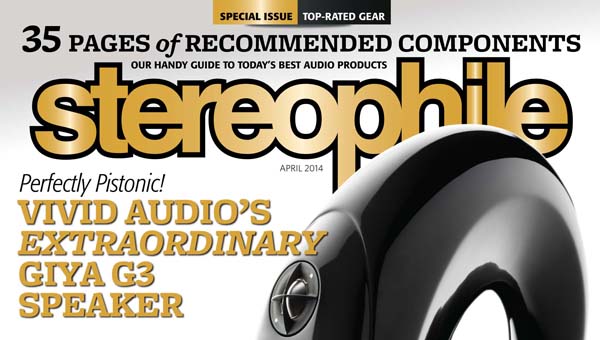
Our cover model is the extraordinary Vivid Audio Giya G3 loudspeaker. Is there room in John Atkinson’s heart for another loudspeaker? My guess is yes, but where exactly does the Giya G3 rank among the countless other contenders that have spent time in JA’s listening room? Other products reviewed in this month’s issue include: MSB’s sweet-sounding Analog DAC and Universal Media Transport, Parasound’s exceedingly versatile Halo P 5 D/A preamplifier, and Zesto’s striking Leto line preamplifier.
In “Sam’s Space,” Sam Tellig has a blast with Musical Fidelity’s truly affordable V-Series products; while, in “Analog Corner,” Mikey Fremer (again) celebrates the continued growth of LP sales in the US; and, up in Cherry Valley, Art Dudley cleans his many LPs with the fun, new discOveryOne record-cleaning machine from Keith Monks Audio Works. In “The Entry Level,” I listen to Audioengine’s D3 and Cambridge Audio’s DacMagic XS—two more contenders in what is possibly the coolest and most exciting type of audio component currently available, and truly a bridge between the formerly disparate worlds of mass-market and high-end audio: the USB DAC–headphone amp. Meanwhile, John Marks enjoys PCM and DSD formats, and is blown away by the Grace Design m905 function-packed DAC.
There’s little point in discussing audio components without also discussing music. Music editor Robert Baird reflects on Nirvana’s last record, In Utero, and becomes acquainted with the English chamber pop band, Lanterns on the Lake. Our “Recording of the Month” is the new Beethoven cycle, The Symphonies and Reflections, with conductor Mariss Jansons and the Bavarian Radio Symphony. Our music reviewers get down with an exciting collection of new releases and reissues.
Perhaps my favorite part of our April issue is Art Dudley’s “As We See It,” in which he fights against bullying and reminds us to trust our own ears.
Thank you for reading Stereophile. We hope you enjoy the issue.
Source : stereophile[dot]com
Audio Engineering: the Next 40 Years

Technology Improvements Follow a Trend
Fifty years ago, people thought Alan Turing was crazy. The father of algorithmic computing, Turing predicted that computers would employ about one gigabit (1GB) of data storage by the turn of the century . http://loebner.net/Prizef/TuringArticle.html">He was right. In 1965, Intel's Gordon Moore famously speculated that the number of transistors on an integrated circuit (IC) would double every two years. He was right, too, though his prediction turned out to be a tad conservative.
The growth of nearly every other technology describes a similarly predictable slope. For example: Since 1990, the cost-performance efficiency (CPE) of wireless devices has doubled every seven months. From 1980, the CPE of video-display technology has doubled every 18 months (footnote 1) And since the early 1950s, magnetic-storage bits-per-dollar has doubled every 18 months (fig.1).

Fig.1 The trend in magnetic storage in bits per dollar.
Since 1970, power consumption per data instruction has halved every 18 months. The cost of DNA sequencing has halved every 10 months since 1990. (NEC is now shipping a portable crime-scene DNA analyzer that takes just 25 minutes. The cost of transistors has halved every 16 months since 1970. One transistor now costs less than the ink for one letter of newsprint (fig.2).

Fig.2 The trend in transistor manufacturing cost.
Similar CPE slopes are seen for dynamic RAM since 1970 (18-month doublings), CPU calculations-per-second since 1950 (24-month doublings), CPU million instructions per second (MIPS) per-dollar since 1950 (22-month doublings), Internet global backbone bits-per-second (14-month doublings), Internet data traffic (7-month doublings), and growth in supercomputer floating-point operations per second (FLOPS) since 1990 (14-month doublings). The list continues for scores of technologies, including audio technologies.
Audio Dynamic-Range Innovations Follow a Trend
At the beginning of recorded sound, in 1890, we achieved a systemic dynamic range of 15–20dB, which is equivalent to 3 bits. By the 1930s, vacuum tubes, condenser microphones, and electric cutter heads had improved dynamic range to 35–40dB (6 bits). Magnetic tape gave us a 60–70dB range and more, especially once noise-reduction technologies like Dolby SR were available (12 bits). With the advent of commercial digital recording in the 1970s and '80s, early digital systems were capable of a dynamic range of about 90dB (15 bits).
Today, we can achieve a best-case, unweighted, systemic dynamic range of 110–115dB (19 bits) from concert hall to home playback, but only under pristine controlled conditions. (A typical high-quality home system playing better-than-average program material delivers around 16 bits.)
I've visualized the history of audio dynamic range on a growth graph (fig.3):
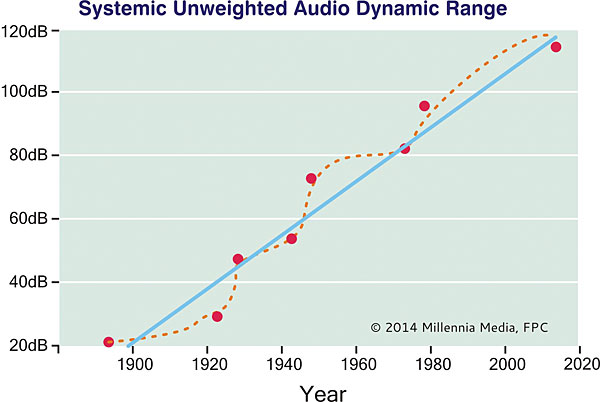
Fig.3 The history of whole-system, unweighted, dynamic range capability.
Two things should be noted. First, looking at technology growth with too narrow a time frame obscures the long-term trendline. For instance, from 1885 through 1925, acoustic dynamic range didn't improve much—it took the breakthrough innovation of electric recording to significantly improve dynamic range. Second, economic incentive drives innovation and improvement. Generally, those technologies with the greatest economic incentives improve the fastest.
If we "average" (or "smooth") 120 years of dynamic range, we see that its growth is predictable. From the beginning of audio recording, the dynamic range of commercial audio formats has improved by roughly 0.8dB annually, or about one bit every seven years. We can easily extend this growth slope into the future and expect the trend to continue until the reproduction by audio systems and recording media of real-world dynamic range is no longer limited by technical or economic factors.
Trends Predict the Future
The economic engines driving the next decades of media technology will be gaming, film, and television, which now have a combined global revenue of almost $500 billion.
The future of audio/video could be called the first-person-shooter era of media production. The world of high-end audiophile and videophile products—less than 2% of media markets—will not be the primary driver of these emerging technologies. Instead, it will be the beneficiary of this massive investment in innovation.
Thus, to better understand the future of A/V, we need to explore a number of emerging technologies and their possible futures over the next 40 years. Then we will converge our exploration into a singular vision for media creation and delivery—especially A/V creation and postproduction.
Gestural Control
Remember the big, gesture-controlled video screen Tom Cruise used in Minority Report, which was released in 2002? As envisioned for the film by John Underkoffler, of MIT's Media Lab, the actual technology would have likely cost more than $1 million in 2001. Today, we have consumer gesture devices that do more than Tom Cruise could do for less than $100. Samsung televisions respond to hand gestures while you sit on the couch. Hewlett-Packard notebook computers are currently shipping with the Leap Motion Controller (Visit Leap's website to see a video of its significant capabilities.)
How soon will free-air gestural control replace the mouse? When will gestural control become the de facto human/machine interface? Consider this: Today, a company called Microchip sells an e-field gestural-control chip for about $4. That IC comes fully equipped with no fewer than five paralleled A-to-D converters, onboard positional tracking, flash memory, and a powerful DSP engine that interprets myriad forms of 3D human gestures, flicks, angulars, and symbolics. The chip has a 3D spatial resolution of 150 positions per inch, and can track at 200 positions per second.
At $4 a chip, the migration from hardware control to free-air control has begun. One- and two-fingered gestures, different kinds of taps and swipes—our mobile devices and tablets have trained us well. We have become deeply familiar and entirely comfortable with gesture control on hard surfaces. The leap to gestures made in free air is a natural evolution.
Early adopters are already replacing their mice and touch interfaces with gestures. How long before free-air gestures become the standard? Look at the technology's growth slope (fig.4):

Fig.4 The growth of free-space gesture control.
Footnote 1: Display technology cost-performance weighted sum of Resolution, Color Depth, Dynamic Range, Latency, Dot Pitch, Refresh, Contrast Ratio, Viewing Angle, Brightness, and Energy Use . . . vs cost.
Source : stereophile[dot]com
Neil Young's PonoMusic Launches AT SXSW 2014

The actual Pono player is a triangular audio player, built in partnership with Ayre Acoustics (after an earlier partnership with Meridian Audio fell through), that will play all file formats including MP3. Between its board and micro sound card it will feature 128 Gigs of memory, will store between 1000 and 2000 high resolution albums and will retail for $399.00. A special silver Pono player, with an artists name etched in it, and with that artists two favorite albums from their catalog pre–loaded in the player will come later at a premium. The music store hopes to launch in October where it will be a competitor for HDtracks. I briefly listened to several tracks on a prototype player—"The Doobie Brothers,"China Grove, Tom Petty & The Heartbreakers, "Here Comes My Girl," and Dave Brucbeck's "Take Five"—and I liked what I heard but I was outside with a breeze blowing and folks conversing around me.
Young has been demonstrating Pono in his car, a white 1978 Cadillac Eldorado Biarritz. This experience has been documented in a promotional film for Pono that features scores of musicians rhapsodizing about the players sound, and even a visit to the caddy by music legend and former Warner Bros, chairman, Mo Ostin, who speaking about why Pono will work, intones the film’s scariest line: “I know how Neil’s mind works.”
To Young, a longtime foe of compromised sound and a general in the loudness wars, Pono comes down to standing up for artists.
“Our machine is maximized by Ayre Acoustics to be the best it can be for what it is. And it’s sized appropriately to hold a couple of key components. We do one thing and we do one thing well and that’s make a great sounding player, and supply the best sounding files possible of the record, exactly the way the artist made it.”
“A lot of musicians who care are already making high resolution recordings. So that’s not really a big problem. But now everybody’s gonna know because our player’s gonna tell them. You go on the player, on the back pages of a song, past the metadata, you’ll find out what it is. The technical notes explain what people are listening to. So the decisions that are made in the studio, either by the record companies making the transfers from the analogue or whoever, those decisions, that’s honest, it’s all there.”
Asked about how we, those on the right side of the loudness wars, convince average folks, the MP3 crowd, and especially kids that better sound is worth listening to and paying for, Young has a quick answer.
“All they have to do is hear it once. A kid who can hear and they all can…there’s not one kid out there who’s not 100 percent interested in something new. Kids don’t live in the yesterday, they want to live in today, they want to live in tomorrow, so when they hear something better, every kid recognizes it.
“We are making a video in New York City of high school age kids who all brought their earphones in that they use with their phones and we video’d each kid listening on their phones to Pono. All we have is the look on their faces. They’re all knocked out. They’re going crazy. New face, new phones, over and over. They all get it. There are none who don’t get it. Every one of them gets it because they’re alive. They’re systems are all Go! They’re at their peaks. How could they miss it?
“When you feed the body everything, and you give the body all the nuances, then they will look and listen again because that felt good. It’s still feeling good so they keep listening. You want to keep listening over and over again because you’ve got the other 95 percent of the sound. MP3’s are less than 5 percent of the sound. MP3’s are for the dial up modem. They were very clever for the dial up modem, but not too clever for modern society.”
Asked about his hearing, Young smiles.
“My ears are okay. It’s like being the captain of a destroyer for 50 years. There were a lot of gun shots, so there’s been damage but I know that damage doesn’t matter. You have what you have. Garbage in, garbage out. If I’m listening to a piece of crap, I can recognize it. If I’m listening to 192/24, I can tell if it’s as good as it can be or if it isn’t. Even if I went deaf at this point, because I know for everyone who can hear really well, this is the right thing for music, I’d still do Pono.
Pono is being financed so far with an on–line Kickstarter campaign which made its goal of $1.6 millon in 7 hours yesterday. What are the chances that it will survive and prosper?
“As a business, Pono will probably succeed,” Young says. “But if Pono fails, it’s still good for music. It’s good for audio. It’s good for the world. It’s a win win. Nobody loses.
“The one thing we stand for: quality audio. The human body craves good input period. It loves good food. It loves to look at good movies. It loves a beautiful day. It loves great music. The ears are the window to the soul. You put it all in there and you’re going to have a happy soul. Or a sad soul if it’s a sad song, but they’re gonna feel the whole thing and that’s what we want to do.”
In classic Young fashion, while he is promoting Pono he has also cut a new record of “my favorite songs in the world,” on a 1940’s vintage disc cutter. He describes the end product as “beyond Lo-fi. It’s so gone. But it has a certain quality.” While I waited for my turn to speak to Young, scarfing free cookies if the truth must be told, I overheard a conversation about Young thinking audiophiles were “weirdos.” Needless to say, when I got my chance, it was my first question. He chuckled heartily.
“No, they’re geeky. I understand. I’m not an audiophile but I’m very geeky about other things. And I’m nerdy. My daughter, when she was like 9 years old, busted me for being nerdy. She recognized it, you know. No, I appreciate it. Being geeky and nerdy about certain things is really an attribute it’s not a problem.
So sayeth the Neilness.
Source : stereophile[dot]com
Listening #135
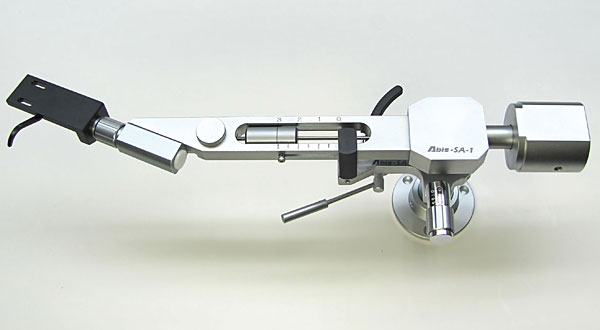
In contrast to the artisanal and altogether wooden Woody, the Abis SA-1 ($2350) is machined from aluminum alloy and assembled in a Tokyo factory that, I'm told, has 40 years of experience making tonearms under a different brand (which Sibatech declines to name). Indeed, my review sample seemed at least as well made as any other arm I've used, and although the SA-1 isn't produced with the sort of luxurious finish one sees on the Ikedas and Zetas of the world, its appearance and feel are solid, serious, and professional—not cobby.
Broad in the beam
According to Abis, the SA-1's effective mass, is "approximately 20 grams" and Sibatech and Mockingbird are up-front in saying that this very substantial tonearm is designed for use with low-compliance phono cartridges. Thus the SA-1, with its pivot-to-stylus distance of just under 9", is a unique alternative for those who want a tonearm of high mass but not of transcription length (12"), the latter phrase describing virtually all contemporary tonearms of greater-than-average effective mass.
The most obvious junk in the SA-1's trunk is its wide armtube of rectangular cross-section, a design distinction that gives it a passing resemblance to Dynavector's classic 507 models. Adding to that impression is the fact that the SA-1's offset angle, specified as 22°, is achieved not with a bend or a curve in the tube but with what appears, at first glance, to be a separate structural element, mounted at an angle to the main "beam." (A closer look reveals that this frontmost portion of the Abis arm is neither adjustable nor separate—the whole of it is apparently cast in one piece before being machine-finished—and so the hyper-adjustable Dynavectors remain unchallenged in that regard.)
The Abis SA-1's armtube is sufficiently wide—presumably to enhance stability during play, although its maker makes no such claim—that it remains a high-mass tonearm even with some of its junk drilled away, to make room for the signal wires and a distinctive downforce mechanism. The left- and right-channel wires occupy separate tunnels on the arm's underside, spaced as far apart as possible to maximize stereo separation; the downforce mechanism is a cylindrical weight that slides along a slender axial shaft, all within a hollow at the center of the armtube. Downforce is calibrated in increments of 0.5gm up to 3gm; a small, round auxiliary weight can be fitted into a hole of its own for another 1.5gm of pressure. The spring-actuated antiskating control, located near the arm pivot, is calibrated only to 3gm—a not-unreasonable limit, given the questionable value of bias force at higher downforces.
Installation was straightforward, eased by Abis's inclusion of a plastic arm-mount template that slips over the record spindle to precisely indicate where, on the armboard or plinth, one must drill the mounting hole (which is coincident with the exact center of the arm's horizontal pivot). That was ostensibly the most critical task—yet, as with all such tonearms and all such mounting collets, the screw holes required to hold the collet in place are equally important: To get them wrong is to squander whatever degree of accuracy was brought to bear on the primary mounting hole.
To solve this dilemma, I applied to the SA-1 an installation trick I've been using for the past few months. I began by choosing a drill bit that measures exactly the same as the arm collet's inside diameter—in this case, 20mm—then drilled the hole in precisely the spot indicated by the template. That done, I used cyanoacrylate to glue the collet to the surface of the armboard, having used an appropriately sized wooden dowel to precisely align the two openings and orient the collet's locking screw in the desired direction. After the adhesive dried, I used the holes for the collet screws to mark the precise points for the drilling that remained. (I have sometimes simply used a glued-down collet's screw holes as guides for my drill bit, with fine results.)
In setting up the SA-1, I encountered only one real obstacle: Its detachable headshell came equipped with signal leads that were too stiff and unyielding to allow any of my phono cartridges to be scooted all the way back to the rearmost position permitted by the headshell's adjustment slots. I compensated by substituting a set of (non–plastic-coated) leads that were much more forgiving—especially with the superb Miyajima BE II mono cartridge, whose staggered output pins help prevent this sort of problem from happening in the first place.
A final word about setup: Prior to setting downforce, I found that it was impossible to completely balance the SA-1's armtube under zero-downforce conditions. I don't know if that was due to the precise location of the arm's vertical bearings, the height of the counterweight relative to that of the fulcrum, or some other factor. The greatest practical consequence was that uncertainties in zero-downforce settings translate into uncertainties in positive-downforce settings, thus forcing the use of an accessory downforce scale during setup and disregarding the SA-1's built-in calibration for all but the coarsest settings. A secondary consequence, of concern only to reviewers and the insecure, is that the lack of ability to float an armtube makes it difficult to assess the quality of a tonearm's bearings. (The distributors of the SA-1 say that the quality of its ball-and-race lateral and vertical bearings is very high indeed.)
Tight, also
Notwithstanding the above, it wasn't long before I had the Abis SA-1 up and running on my lovingly maintained, early-'60s Thorens TD 124, with my Denon 103 cartridge installed and aligned in accordance with standard Baerwald geometry. (The Denon would be followed by my Miyabi 47 stereo cartridge and Miyajima BE II Mono cartridge.) After adjusting the cueing platform to compensate for the 124's unusually low-slung platter, the Abis arm was ergonomically good—and the plastic armrest clip that I at first cursed proved its worth in keeping the arm from flinging itself upward during cartridge changes.
With the first record I played—Country Cooking's 14 Bluegrass Instrumentals (Rounder 0006)—I was almost startled by the SA-1's tactile directness and musical rightness: It sounded remarkably good from the get-go. One expects a certain level of sonic immediacy from this album's twin-banjo assault, and the Abis arm did not disappoint. Yet it went further than any other 9" arm of my experience in applying the same tactile qualities to mandolin, violin, double bass, and even Russ Barenberg's beautifully phrased guitar lines, especially in "The Old, Old House" and "Big Ben."
The SA-1's ability to communicate tactile impact—or at least to not diminish it—was marvelous. The percussion in "Autumn," from Joanna Newsom's Have One on Me (Drag City DC390), leapt from the loudspeakers with as much apparent force as when I use my reference tonearm, the EMT 997 (which is mounted on a Garrard 301, with the attendant benefits of greater motor torque and a less lossy drive system). Ditto the notes Newsom plucked from her Lyon & Healy concert harp, which attained a similarly impressive level of force, combined with impressive timbral richness and color, each note blooming with realistic tension and substance. Here, as with other LPs, the SA-1 gave full, clean voice to the treble range, at times skating right up to the border between neutral and bright without ever tipping over—and its abundance of rich midrange color prevented the arm from sounding light, per se.
The Abis also managed, somehow, to turn my Altec Valencia speakers into imaging champs. With no loss whatsoever in the performance areas with which I'm most concerned—impact, timing, drama, flow, timbral color and substance—my Abis-fueled system compellingly informed me of the locations of most instruments in the London Symphony Orchestra in my favorite recording of Schubert's Symphony 9, led by Josef Krips (Decca/Speakers Corner SXL 2045). The Abis extracted equally good spatial performance from other recently enjoyed favorites, including the Grateful Dead's fine-sounding American Beauty (Warner Bros./Mobile Fidelity Sound Lab 1-014) and Bill Frisell's Good Dog, Happy Man (Nonesuch 79536-1).
But never mind all that. The Abis just plain damn played music, dammit. Melodies in that Schubert symphony were more compelling than I remember hearing through my hi-fi in a very long time, and with the SA-1 and the Miyabi 47 on my Thorens, I reconnected with American Beauty more musically and emotionally than sonically, reveling in the strange combination of adventurous, even audacious arrangements and performances of music that is, at its heart, as steeped in tradition as can be.
Footnote 1: This tonearm's cumbersome full name is the String Theory Woody tonearm from Pete Riggle Audio.— Ed.
Footnote 2: Abis/Sibatech Inc., Room 1301, 8-25-22 Higashi-Suna. Koto-ku, Tokyo 136-0074. Japan. Tel: (81) 3-3645-1646. Fax: (81) 3-3645-1948. Web: www.sibatech.co.jp. US distributor: Mockingbird Distribution, LLC, Van Alstyne, TX. Tel: (214) 668-2509. Web: www.mockingbirddistribution.com.
Source : stereophile[dot]com
The Entry Level #39
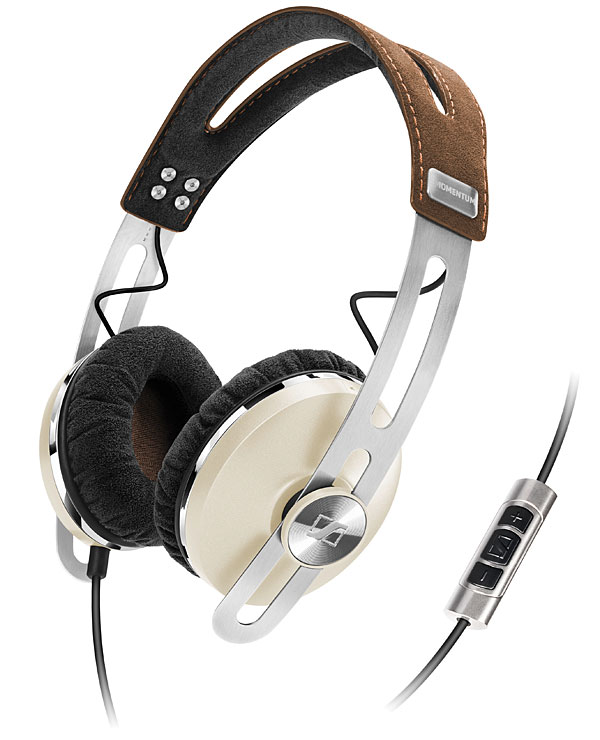
Sennheiser Momentum on-ear headphones
Last December, I wrote about Sennheiser's excellent Momentum over-the-ear headphones ($349.99), which are designed to look as good as they sound. While I loved their elegant appearance and warm, detailed sound, I found the fit too tight and awkward for extended listening. After about 35 minutes, I'd have to remove the headphones due to sharp pain around my ears.
Sennheiser now makes an on-ear version of the Momentum ($229.95), which, aside from being less luxuriously appointed, $120.04 cheaper, and having smaller earpieces, is nearly identical to the more expensive model. The oval earpieces slide up and down on the same stainless-steel headband, but, rather than boasting hair-sheep leather, the on-ears' earpads are covered in a synthetic material called Alcantara, which looks and feels practically identical to suede. Similarly, where the ridge of the larger version's headband is cushioned and covered in more leather, the on-ear version's cushioned headband is covered in more Alcantara. The over-the-ear version has earpads 2.5" wide by 3.5" long, while the on-ears' pads are only 2.25" wide by 2.875" long. Interestingly, I found the on-ears a bit more comfortable than the larger over-the-ears. Still, to avoid any pain around my ears, I needed to periodically adjust the headphones' placement on my head, and remove them entirely after about 45 minutes of listening.
Though the two models appear to use the same 1.4m cable, the on-ears' cable has a less robust microphone/volume control and a simple, fixed-angle plug. Like its predecessor, the on-ear Momentums come packed with a second cable, a stereo-to-minijack adapter, and a handsome carrying case. Unlike the original, which is currently available in only black or brown, the on-ears lighten things up with several fun options: green, blue, pink, ivory, brown, gloss black, and bright red. My samples, with ivory earpieces and a brown headband, exhibited flawless build quality.
I was immediately impressed by the on-ears' clean, clear, extended highs and spacious, open overall sound. The expert production and awesome panning effects in "Your Body Feels," from Four Tet's Beautiful Rewind (320kbps MP3, Text TEXT025), create the illusion of a propeller-like object that's spinning and whirring, moving from left to right across the stage, while alternately approaching and retreating. The on-ear Momentums opened a wide space and did a surprisingly good job of communicating those senses of movement; the sound was physical, intense, and dramatic—not as crazily dramatic as through the PSB M4U 2 headphones ($399.99), say, but dramatic nonetheless, and more so than I could have hoped from such a compact, affordable design. And in "Palace," from Wild Beasts' beautiful new Present Tense (320kbps MP3, Domino WIG279), the Sennheisers gave drummer Chris Talbot's closed hi-hat just the right amount of sparkle and bite.
Despite these achievements, the on-ear Momentums were, in almost all ways, easily outclassed by their larger siblings. The more expensive, over-the-ear design produced a bigger, more spacious overall sound, with sweeter highs, cleaner attack transients, a richer and more present midrange, and tighter bass. These differences were most readily apparent with files of higher resolution, such as "Sleeping Is the Only Love," from the Silver Jews' Tanglewood Numbers (1037kbps ALAC file ripped from CD, Drag City DC297); and "Levitation," from Pinch & Shackleton's eponymous album (1411kbps WAV file ripped from LP, Honest Jon's HJRLP59). With files of much lower complexity—a 64kbps mono AAC file of my band Lip Action's radical new single, "Bagels and Roses," for instance—differences were much harder to hear. Both models tamed this recording's inherent brashness, making the track easy to listen to and enjoy.
I also compared the on-ear Momentums with another on-ear design, Stereophile's 2013 Accessory of the Year, the B&W P3 ($199). They sounded remarkably different. I'm tempted to say that if one of these headphones is right, the other must be wrong, but I enjoyed listening to music through both of them—really. The Sennheisers' well-extended, natural-sounding highs and more spacious overall sound gave greater drama and physicality to Four Tet's "Your Body Feels," but the B&Ws' more forward midrange made the track's sampled tenor saxophone sound as if it were being played by a living, breathing human. With Wild Beasts' "Palace," the Sennheisers reproduced the snare drum with more rattle and snap, and gave the hi-hat just the right amount of sparkle and bite, but the B&Ws made the analog synth sound absolutely marvelous—large, warm, and colorful. The two headphones sounded nearly identical in the bass. And the B&Ws were much gentler to my head—I could almost forget that I was wearing them.
Ah! Why can't I have the on-ear Sennheisers' high-frequency clarity and the B&Ws' midrange presence? Well, I can—with the over-the-ear Momentums or PSB's M4U 2s, for example. Still, I could live happily ever after with either the smaller, more comfortable on-ear Momentums or the B&W P3s. The Momentums combined clean, accurate highs with a slightly recessed midrange and a slightly overripe bass; the B&Ws took that same bass quality and partnered it with overly polite highs and a weightier, more forward midrange. Neither is perfect. Both are excellent.
AudioQuest DragonFly v1.2
I did all of the above headphone comparisons sitting at my desk, staring at my laptop, and using the latest version of AudioQuest's popular DragonFly USB DAC–headphone amplifier. Aside from some small, tidy certification markings on its backside, the DragonFly v1.2 is identical in size, shape, and functionality to the original model—and, at $149, costs $100 less. Like the original, the v1.2 handles file resolutions up to 24-bit/96kHz, making the device virtually plug-and-play for both PC and Mac users; no additional drivers are required, but you might have to change a few settings in your computer's control panel—the DragonFly's "flight manual" will guide you through the process.
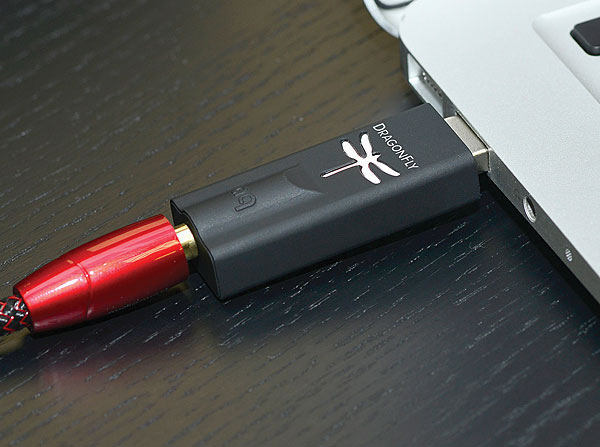
The new DragonFly still has a USB jack at one end, a 3.5mm jack at the other, and a top-panel dragonfly emblem that changes color in accordance with the sample rate of the file being played: green for 44.1kHz, blue for 48kHz, amber for 88.2kHz, and magenta for 96kHz. It still uses Gordon Rankin's Streamlength asynchronous USB protocol and it's still made in the USA. The differences—all improvements, as far as I'm concerned—are found inside, and include a revised power supply and a simplified, more direct signal path between the DAC and headphone module.
The sonic differences between the original and v1.2 DragonFlys were almost as obvious as those between the Sennheiser Momentum and B&W P3 on-ear headphones. Where the original DragonFly excelled in clarity and detail, v1.2 added a richer, more colorful midrange, improved spatial abilities, and a greater sense of ease. Through the DragonFly v1.2, "Sleeping Is the Only Love" sounded thrilling and beautiful, with an awesome amount of space around the drum kit, a solidly focused center image, and overall clarity and tonal accuracy that made following guitar riffs and subtleties of drumwork a total pleasure. Best of all, though, was the v1.2's way with David Berman's simple, familiar voice: Singing "I'd crawl over 50 yards of burning coals just to make it with you," he sounded drunk and restless with desperation and love—just as he should. I believed every word of it.
Source : stereophile[dot]com
Vince And His Covers
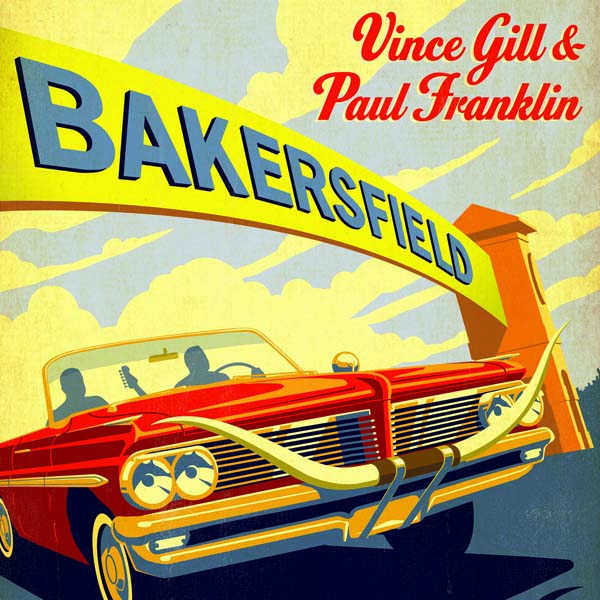
In his brief liner note, Merle Haggard, says he feels “highly complimented” and says he likes “the whole album or to be technically correct these days the whole “CD.” Sorry Hag, even though the country music audience continues to be the CD’s most loyal followers, the pendulum has swung back yet again to the LP and now, the download. To fans of Buck, Hag and all the great music that came from the central valley of California in the period from 1950s to 1970, this is a greatest hits compilation. No undiscovered gems or unrecorded originals here. This one’s played just for the hits, or a selection of the many Bakersfield hits, all of these released between 1961 and 1974. What’s most impressive here after the obvious care and respect for the forbearers that went into this project is Vince Gill’s voice. One of the finest vocalists in the history of popular music, Gill, through his singing, both pays tribute to the originals here but also makes these oft– heard hits his own. The fact that he can put over Buck’s great ballad, “Together Again,” and it’s stylistic opposite, Hag’s “The Fightin’ Side of Me,” with equal verve is an amazing feat. Of course he’s also a hot guitar picker. And then great talent draws great talent and so for this project he’s surrounded himself and by all accounts a class act all around, here surrounds himself with a band of A list Nashville pickers headed by his cohort Franklin, fiddler Kenny Sears and oh yeah, the great bassist Willie Weeks!
If there’s anything to question here—and this is a very mild criticism at best—it lies with the tempos. While it’s commonly held that classic country music is all about the “stories,” it’s the tempos that are actually the key to making the music of both Haggard and Owens work. The opener, Owens’ “Foolin’ Around” is played at exactly the right snappy tempo whereas the next track “Branded Man” seems a step slow. But again this is nitpicking. Listen to “The Bottle Let Me Down,” tells you most of the tempos here are right on.
Released to coincide with an exhibit on California country music that opened in Fall 2013 at the Country Music Hall of Fame, this cover of this record has been designed to look stained along the edges, just the way a country LP of its vintage often looks. Nice touch! Rather than launch into a tirade over the merits of the pop rock that passes for country music today, let’s just say that because Bakersfield was a project born of a passion for what’s great about country music, and recorded in a home studio where time is an affordable luxury—and everyone sounds like they had a good time making it—this is one of the best country records to come out of Nashville in a very long time.
Source : stereophile[dot]com
ASUS Xonar Essence One Muses Edition D/A processor–headphone amplifier

I was impressed by what I heard from these cards, and concluded in a Follow-Up that "the Xonar Essence STX and its PCI-bus equivalent, the Xonar Essence ST, can be recommended to those on restricted budgets who wish to incorporate a PC into their high-end rigs." So when ASUS announced that it was introducing a version of its standalone Xonar Essence One D/A headphone amplifier fitted with JRC's high-performance Muses op-amps, which I had first experienced when I reviewed the Esoteric D-07 D/A processor in January 2011, I asked for a review sample.
The Muses Edition
The Xonar Essence One is a hefty processor housed in an elegant, black-painted enclosure. The basic Essence One costs $599; the Muses Edition, which can be distinguished by the black color of the stylized lion graphic on the top of its extruded-aluminum sleeve, costs $899. On its front panel are, from left to right: a power button; buttons to select Upsampling, Input, and Mute (the selected input LED turns from blue to red when Mute is selected); a large volume control for the line outputs, to its right an arc of blue LEDs; a smaller volume control for the headphone output; and a single ¼" (6.3mm) stereo headphone jack. Because there are independent volume controls for the line and headphone outputs, the line output doesn't mute when headphones are plugged in. On the rear panel are pairs of RCA and XLR jacks for the single-ended and balanced line outputs, respectively, and input jacks for USB data and S/PDIF data on TosLink and coaxial links.
When the upsampling function is off, the sample rate of the incoming data—44.1, 48, 88.2, 96, 176.4, or 192kHz—is displayed by the arc of LEDs. When the upsampling button is pressed, data at 44.1kHz are upsampled to 352.8kHz; data at 48kHz and its multiples are upsampled to 384kHz. ASUS calls this "Symmetrical 8x upsampling," because the upsampled frequency is an integer multiple of the incoming rate. None of the LEDs illuminates when upsampling is engaged. However, there is an LED at the top of the arc labeled Bit Perfect; though this never lit up when I used the Xonar processor with my Mac mini or MacBook Pro, it is supposed to do so when the Essence One is connected to a Windows PC and the necessary ASIO driver (supplied on a CD-ROM) is installed. (I couldn't verify this, as all my auditioning and measuring was with Macs.)
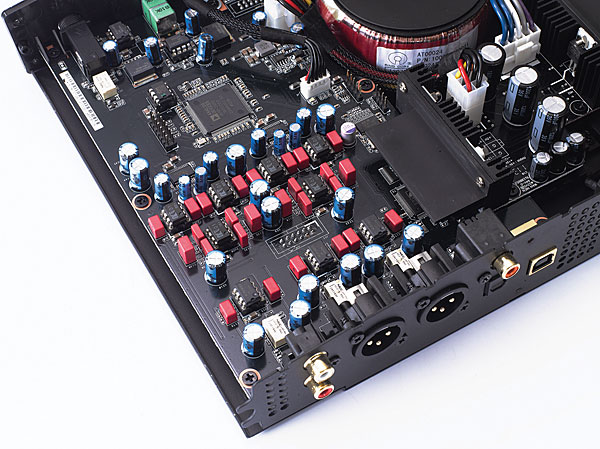
Inside the box, the circuitry is neatly laid out on a large printed circuit board, with a cutout in the board for the toroidal power transformer. S/PDIF data are routed to an AKM AK4113 receiver chip; USB data are handled by a C-Media CM6631 USB receiver (the same chip used in the Schiit Bifrost DAC reviewed by Jon Iverson in August 2013). The audio data are passed first to an Analog Devices SHARC ADSP-21261 40-bit floating-point DSP chip, then to a pair of TI's PCM1795 DAC chips.
The PCM1795 is a two-channel, 32-bit–resolution device that is pin-for-pin compatible with the earlier and widely used PCM1792 chip; according to its datasheet, the PCM1795 is DSD-capable, but the Essence One will not decode DSD data. Also according to its datasheet, the PCM1795 is intended to operate up to a sample rate of 200kHz, so I'm not sure how ASUS is able to use it at 352.8 or 384kHz when upsampling is engaged. I wondered, as the chip is a two-channel part, each channel could be fed alternate samples, to give an effective doubling of the sample rate, as was once done by Stan Curtis in a mid-1980s Cambridge Audio CD player. However, my measurements (see Sidebar) suggest this isn't the case.
Unusually, all of the eight-pin op-amp chips, a mix of JRC and Muses devices, are socketed. The six Muses 01 dual op-amps, which follow the DAC chips, are made with advanced fabrication techniques said to reduce crosstalk and produce better-balanced left/right channel symmetry, and use oxygen-free copper leads. The headphone amplifier appears to be based on a pair of TI's LME49720 high-performance op-amp chips and an LME49600 high-current output driver; the line outputs appear to be based on TI's LM4562 ultra-low-distortion, low-noise, high-slew-rate op-amps. Other than the headphone output, all the analog audio circuitry is heavily bypassed with local electrolytic and plastic-film capacitors. Overall, the parts count and the quality of those parts are very high for a relatively inexpensive product.
Sound Quality
I used the Xonar Essence One Muses Edition for all my regular headphone listening during the fall of 2013, as well as during the preparation of my review of the Audeze LCD-X headphones elsewhere in this issue. I also used it in my big rig (see the "Associated Equipment" sidebar). Although the Xonar DAC had already been reviewed by Michael Lavorgna and Dinny FitzPatrick on, respectively, our sister websites AudioStream.com and InnerFidelity.com, I didn't read my colleagues' reviews until I had finished my own auditioning. But my impressions of the Xonar's sound quality to some extent echo theirs.
Used as a DAC without upsampling engaged, the Xonar Essence One didn't resolve recorded details as readily as the NAD M51 and Auralic Vega, though it's fair to note that those DACs cost very much more. There was a smooth, rounded-off quality to the Xonar's line outputs that was a benefit with typically overcooked rock recordings, such as the Pretenders' "Talk of the Town" and "Back on the Chain Gang," from The Singles (ALAC files from CD, Sire/WEA; and yes, I am rediscovering and relishing that delicious sob in Chrissie Hynde's voice).
But this character obscured the fact that my reissue of Richie Havens's 1969 album Richard P. Havens, 1983 (CD, Polydor 835 212-2) had apparently been mastered from an LP rather than from the original master tapes. And the dry acoustic of Yamaha's YASI recital hall in Attention Screen's "13 Trojans of Vundo," from their live recording Takes Flight at Yamaha (16/44.1 master file for CD, Stereophile STPH021-2), also seemed a little suppressed compared with the Auralic Vega's presentation. Chris Jones's fretless Fender Jazz bass guitar also sounded a touch softer, but the Essence One still revealed the hit in sound quality resulting from the lossy audio encoding in the video from the concert that I posted on YouTube, to which I had added the audio mix from the CD.
Article Continues: Page 2 »
| | |||||||||||||
Source : stereophile[dot]com
Everest Records Returns in All its Glory

Among the gems of the Everest catalog are the very first recording of Aaron Copland conducted of his own work, the Symphony No.3 that includes the spectacular "Fanfare for a Common Man"; Sir Adrian Boult's premiere recording of Ralph Vaughan Williams' Symphony No.9, made on the day the composer died and issued as a tribute; Sir Malcolm Arnold conducting his own works; pianist Jorge Bolet performing Chopin; Ernst von Dohnanyi playing his own piano music; Leopold Stokowski's versions of Tchaikovsky's Francesca da Rimini and Hamlet; Eugene Goosens' prized disc of ballet suites from Antill's Corroboree and Ginastera's Panambi; and Sir Malcolm Sargent conducting Tchaikovsky's Symphony No.5. Some of these titles are in the latest batch of Everest releases, and are due to arrive at HDTracks in the not too distant future.
HDTracks' David Chesky, responding to email shortly after returning from a production of one of his operas in Poland, says, "I like the pairing of Villa-Lobos' Little Train of Caipira with Ginastera's ballet suites a lot. In truth, I find all of the Everests to be wonderful. Bert Whyte [Everest producer and engineer, who, together with label co-founder Harry Belock, decided to record on 35mm film rather than ½" magnetic tape because they considered 35mm sonically superior] was laying the foundation for all audiophiles to follow."
Lutz Rippe, a classically trained clarinetist who has restored and remastered the titles for the master tapes' owner, Countdown Media in Hamburg (a subsidiary of BMG Rights Management), told Stereophile that he began working on the project in 2009. It took a few months to become familiar with the tapes and how to perform post-processing before the first releases, most of Beethoven's nine Symphonies performed by the London Symphony Orchestra under Josef Krips, could see the light of day.
"Many of the tapes are quite deteriorated or have suffered from vinegar syndrome, which is a common problem for 35mm tapes that have not been stored optimally," he explained. "The tapes contain acetic acid, and over time, the acetic acid precipitates and the tapes' components fall apart. The effect is that the tape shrinks, and the sides curl a bit. Thus, you may have problems with wow and flutter on the recording, which are time-consuming to fix."
Countdown Media's Albrecht MB-51 conversion machine is equipped with a special laser shrinkage detector that was specifically designed to handle tapes that suffer from vinegar syndrome. Instead of using a sprocket wheel for playback, which on shrunken tapes can result in damage and lead to occasional skips that cause the tape to run fast, the machine uses a laser to detect the sprocket holes in the tapes and play them back at the desired speed. In addition, a special replay head increases the pressure of the tape against the head to reduce wow and flutter effects.
Rippe reports that there's no particular reason why the current 61 titles were remastered before the remaining batch sees the light of the day. Remastering is a time-consuming process, and must be accomplished while working on a host of other projects, one of which includes re-releasing the Vox catalog, which is rich with early recordings by Alfred Brendel.
"Everything that is published and released has its special story," says Rippe. "My honest opinion is that the vast majority of recordings sound very good, and are absolutely worth listening to. If you were to see how torn the masters sometimes are, you'd be amazed at the sound that comes out of them."
He also notes that about 15 of the Everest titles, including Tchaikovsky's Fifth, were originally transferred in 24/192 by Bernie Grundman Mastering for reissue by Classic Records some time back. "I did some additional restoration work on those transfers," Rippe says. "They were excellent in general, but some of them suffered from wow and flutter in certain places. Now that our specialized software has repaired those problems, we've ended up with great remasterings that mate perfectly with the other titles we're remastered in Hamburg."
Source : stereophile[dot]com
Guy Clark: For the Sake of the Song

Photo: Nashvilleportraits.com
Pack up all your dishes.
Make note of all good wishes.
Say goodbye to the landlord for me.
That son of a bitch has always bored me.
Throw out them L.A. papers
And that moldy box of vanilla wafers.
Adi¢s to all this concrete.
Gonna get me some dirt road back street
—from "L.A. Freeway"
As songwriters go, Guy Clark has been touched by the muse more than most. Unfortunately, in recent years he's also been visited by illness and heartache. In June 2012, his wife of 40 years, Susanna Clark, who was both a songwriter ("Easy from Now On") and an artist (the cover of Willie Nelson's Stardust), died in Nashville. In the past several years Clark, 72, has battled lymphoma, had his knees replaced, and undergone an arterial replacement in one leg. He was being treated for skin cancer when I visited his home, south of Nashville, in October 2013.
Earlier that year, despite or perhaps because of these troubles, Clark wrote and recorded one of his best albums, My Favorite Picture of You, which has since been nominated for a Grammy Award for Best Folk Album. Clark has often joked that every time he's nominated for a Grammy, he ends up losing to Bob Dylan. In 2013, Dylan didn't release a new record. In 2012, This One's for Him: A Tribute to Guy Clark, was also nominated for Best Folk Album. Finally, Clark was one of two recipients of the Country Music Association's Poets Award for 2013. His fellow recipient was one Hank Williams.
"Yeah, me and Hank got it. It's pretty far out. I don't usually go to those kind of things, but for this I did . . . he didn't show up."
Although frail and unsteady on his feet, Clark, fortified with a hand-rolled cigarette and a cup of strong coffee, sat down in the sunshine streaming into his combination writing room and luthier studio for a wide-ranging chat. The conversation opened with some mutual marveling about how fast Nashville is growing, and the true meaning of pro hockey in the South.
"I went downtown the other day and I didn't know where I was. I get lost. I was just like, 'Where did all this come from, man?' I don't know anything about ice hockey, but I just think, well, shit, man, you didn't play it as a kid, how do you expect to have a professional team, you know? It's like ice hockey in Jamaica. I'm just, like, stunned. Stupefied."
When it comes to the sanctum sanctorum of his writing room, Clark has a plan. "I always had a dartboard in my writing room, and when I'd get stuck I'd stand there and throw darts. Now, I write and build guitars in the same room. What I like is, if I get stuck on a lyric, I can get up and walk five steps and I'm at my workbench, doing something with my hands, and it clears my head. And then, while I'm waiting for glue to dry, all I have to do is take five steps back to the song I was working on. It's the right side of the brain and the left side of the brain. Sitting and writing is real cerebral—you sit and try to conjure up something, or remember something, or make it come together in an artistic or poetic way, as opposed to making sure you got that glue joint right. And those two things feed off of one another, I think."
Although he's often been called a craftsman, whether for building guitars or writing songs, Clark dislikes the term. "When Ken Irwin [of Rounder Records] bought the three Warner Bros. albums [Guy Clark, The South Coast of Texas, Better Days] for re-release, he decided he wanted to put them in one package, which is fine with me—I didn't really care. But when he decided to call it Craftsman, I should have put a stop to it right then, which I could have. I let that happen without thinking about it, without thinking about how I felt about it. I've tried to steer it away from that ever since. I don't consider it craft; I consider it art, or poetry."
When it comes to songwriting, it's the words, like the song lyrics quoted above more than the music, that Clark considers his strong suit.
"Sometimes the melody strikes me first, of course, but for the most part it's the lyrics. I really enjoy reading. I have read all my life, and was really exposed to a lot of good literature, and especially poetry—Dylan Thomas. Townes [Van Zandt] and I used to think we were pretty hot shit, and we'd put on a tape of Dylan Thomas reading his own work, and it was just like, 'Oh shit.'" He rolls his eyes and chuckles.
"Lyrics have the music of the language, like poetry, and that's music to me. Is Bob Dylan a poet? Of course he is. I've always tried to make my lyrics stand on their own without the music. You can read 'em and it reads like a poem. There's not a lot of 'Oooooh, Baby Baby's in there."
At the heart of My Favorite Picture of You is the title track, its inspiration is explained in its title. The cover art is a photo of Clark holding a photo of his wife, who looks none too pleased.

"Townes and I were drunk on our ass in that house," Clark says with a dismissive wave of his hand. "She'd just had enough. She'd heard it all. And we were jerks. She just walked outside and somebody took that picture. After it was taken, I probably went outside and apologized. The first time I saw that picture, I just thought, 'That's Susanna, man, and she is pissed off. You don't fuck with her!' What I like about it is the austerity. She never took a bad photograph. She was always just . . . beautiful, you know? And she always wore her heart or her feelings on her sleeve. She didn't try to be something she wasn't, or act like she wasn't pissed off. It just struck me that that was always my favorite picture of her."
The mention of Townes Van Zandt, the late and very great Texas songwriter remembered as much for his rough and rowdy ways as for his bittersweet songs, reminds me of a famous quote, attributed to Clark, about how Van Zandt wouldn't have died "if the hospital would have just given him a drink."
"I think probably Jeanene [Van Zandt, Townes's ex-wife] said it. She was with him, and they were in Memphis, and he'd broken his hip and wouldn't go to the doctor. He was really in pain, and they wouldn't give him alcohol. All he wanted was a drink. And he was really an addict. She said, 'I'm taking him outta here!' She took him out against hospital rules and drove him back to Nashville, and first thing she did was find a liquor store so he could, you know, keep from going into delirium tremens or whatever. But there was no other way for that to happen; he was bound and determined to die. I think he was laying in bed, and one of the kids came in and said, 'Mommy, I think Daddy's not breathing.'
Source : stereophile[dot]com
Stirling Broadcast BBC LS3/6 loudspeaker
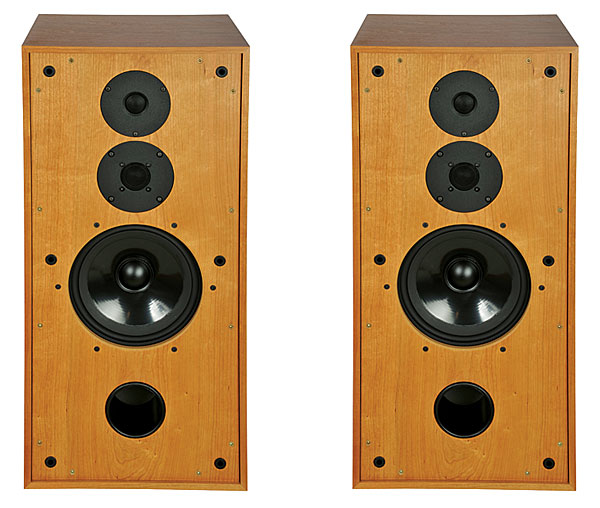
They've had their day, of course—especially such smaller monitors as the BBC-designed LS3/5a. But today, one wonders if their relatively spartan, homely cosmetics have augured against the domestic acceptance of pro-audio speakers. Or perhaps it's the genre's resistance to faddism, kookyism, and Emir-of-Qatar levels of opulence and excess that keeps them on the sidelines of the high-end audio marketplace.
Thus it was with the utmost interest that I received an invitation, from distributor Fidelis Home Audio, to review the LS3/6 loudspeaker ($4590/pair), made in Somerset, England, by Stirling Broadcast, themselves the latest in a line of firms authorized to manufacture the BBC's proprietary designs. Although not an entirely new model—the LS3/6 designation appears to have been used by the BBC as long ago as 1970—this new incarnation was recently designed by Derek Hughes, who has created many successful designs for Harbeth and, of course, Spendor, whose name is derived from those of his late parents, Spencer and Dorothy. But that's another story.
Description
I'll tell it anyway: Just as every Cracker Jack box comes with a prize, and inside every chicken in your grocer's case is a little bag of giblets, so should every review of a BBC-designed monitor loudspeaker come with a history lesson. For it was in 1969 that Spencer Hughes, then working as a BBC laboratory technician, designed and manufactured one of the first practical plastic woofer cones—made, astonishingly, not during the workday at his BBC lab, but in his spare time, at the Hugheses' small house, using an electric room heater and a bedpost. Soon after that, Spencer Hughes mated to his woofer a very nice Celestion phenolic-dome tweeter, and designed around that pair of drivers an entire loudspeaker, intended for both professional and domestic use.
Two distinct things then happened with Hughes's loudspeaker design. First and most famously, it turned into something called the BC1 (footnote 1) which became the premier product of the nascent Spendor company. Second, the BBC forged with Spencer Hughes an arrangement in which the BBC was allowed to distill, from the BC1 design, a very similar loudspeaker for its own use. It is also from the BC1 that two somewhat more contemporary loudspeakers were derived: the Spendor SP1/2, a pair of which I owned and enjoyed during the late 1990s, and the Stirling LS3/6.
The Stirling LS3/6 does not appear, at first glance, terribly different from the Spendor SP1/2—or, for that matter, from late-production samples of the fondly remembered BC1. The LS3/6 is a three-way dynamic loudspeaker in a 25"-tall reflex-loaded cabinet of square cross-section, intended for stand mounting; 17"-tall open-frame hardwood stands, made by Resonant Woods, of Manchester, New Hampshire, cost an additional $399/pair. Each speaker is fitted with a black fabric grille that is the very devil to remove, yet to succeed is to discover and appreciate that the LS3/6's front baffle is as beautifully veneered as every other surface of its enclosure.
All of the LS3/6's drivers are manufactured in Norway (footnote 2) by SEAS, presumably to Stirling Broadcast's specifications. The smaller and uppermost of the two tweeters has a 0.75" (19mm) Sonomex dome, while the larger has a 1" (27mm) coated-fabric dome; each has a ferrofluid-cooled voice-coil and a protective mesh outer cover. The 8.6" woofer has, as you'd expect, a polymer cone 6.5" in diameter, along with a compliant half-roll surround, a ferrite magnet, a very nice cast-alloy frame, and a dustcap made not of stiff plastic but of the softest, most pliable rubber I've ever encountered. Interesting. The two high-frequency drivers are rabbeted into the front baffle; a recess is also made for the woofer's mounting rim, but from behind the baffle, in the manner of recent Harbeth speakers. The front-mounted reflex port is formed by a plastic tube 2.9" (75mm) long and 2.7" (70mm) in diameter.

The Stirling's enclosure is built from three different thicknesses of board: 5/8"-thick MDF for the rear panel, 3/8"-thick MDF for the front baffle, and 3/8"-thick birch plywood for the rets of the cabinet. All panels are veneered inside and out, to prevent warping, and all but the front are covered, on virtually every available surface, with thin sheets of damping material stapled and glued into place. The same inner surfaces are also padded with thick sheets of acoustical foam. The front baffle and rear panel are both removable—a vestige, one assumes, of the breed's history of field use, wherein frenzied techies require quick access to damaged drivers—and are held in place with 12 wood screws each. The screws are secured not with threaded inserts but are screwed directly into furring strips mounted within the enclosure: an eyebrow-raising economy in a $4590/pair loudspeaker that is otherwise exceptionally well crafted.
The Stirling LS3/6 speaks to the world courtesy of two pairs of gold-plated brass terminals, with gold-plated links that can be removed for biwiring. A 6" by 9" circuit board, fastened to the inside rear panel, holds the crossover components: six chokes of varying size (two of them quite large), six film capacitors, and six resistors. I also spotted two sets of miniature jumper switches, both marked "+0.6dB." Interesting.
A word about the packaging: brilliant. The carton and packing for the Stirling Broadcast LS3/6 appear to have been designed by someone with an understanding of physics, some practical experience in sending and receiving large consumer goods, and a distaste for overkill. The carton is spare but sturdy, the packing simple and smart. It works—and it appears as though it could withstand repeated use. Support literature, on the other hand, appears to be nonexistent.
Installation and setup
Perhaps it was good design, good luck, good instincts, or some combination of all three—whatever the cause, the time I spent setting up the Stirling LS3/6s was brief and untroubled. Blessedly, their stands required no assembly, apart from screwing optional spiked feet in the threaded inserts at the bottoms of their feet. (I ultimately uninserted them and settled instead on the comparatively unfussy sound of the wood stands resting directly on my wood floor.) And because thin rubber pads were pre-installed on the top surfaces of the stands, I didn't ever have to subject myself to the drudgery of rolling little bits of Blu-Tak into pea-size balls, as one must do with virtually every other stand of this sort.
Footnote 1: I have been told that the C in the model designation BC1 stands for Celestion; I have no idea what the B stands for, but I would like to think that it's bedpost.
Footnote 2: After opening the cabinet and making note of the labels on the drivers, I began my research by Googling the words Norway and tweeter; my first several hits pointed to a November 25, 2013 article in The Local: Norway's News in English, with the headline "POLICE IN NORWAY ARREST RACIST TWEETER." Interesting.
Article Continues: Page 2 »
| | |||||||||||||
Source : stereophile[dot]com
Audeze LCD-X headphones

And in those early days of recording rock music in stereo, engineers were doing crazy things like panning instruments from side to side, and more—toward the end of "For Haven's Sake," from Richie Havens's 1969 album Richard P. Havens, 1983 (UK LP, Verve Forecast 2317 027), the entire soundstage was repeatedly panned from left to right and then from right to left with additional reverb, the idea being that the musicians are rotating in a lateral circle around the singer and bass guitar. Through headphones, the effect was mind-blowing! (And still is—check out this needle drop.)
Headphones have been a regular part of my music listening ever since, though the reliably unreliable Kosses were replaced by Sennheiser HD420s in the early 1980s, then by Sennheiser HD580s and Sony MDR7506s in the 1990s, Sennheiser HD600s in the early 2000s, and finally Sennheiser HD650s (footnote 1). My headphone experience changed, however, when, following the purchase of my first iPod in 2003, I began using in-ear monitors, culminating in Ultimate Ears 18 Pros and JH Audio JH16 Pros, both of which have bodies molded to fit the dimensions of my ear canals. But I've kept an eye on the world of traditional headphones, and noticed the rave reviews being received by models from Audeze (supposed to be pronounced odyssey, though I tend to say ord-ease).
Stephen Mejias mentioned, in his December 2013 "The Entry Level," that even mainstream music commentator Bob Lefsetz had enthused about Audeze headphones—so I felt it was time I auditioned a pair. I asked for a sample of the new Audeze LCD-X ($1699), a model premiered at last fall's Can Jam/Rocky Mountain Audio Fest.
The LCD-X
These large headphones have planar-magnetic drive-units (footnote 2), 2with a thin-film diaphragm energized by an array of powerful neodymium magnets on both sides. They employ Audeze-patented "Fazor" elements that are said to guide and manage the flow of sound in the headphone. The circular drivers, measure 6.17 square inches, are housed in polished, black-anodized aluminum earpieces, with generously sized pads made either from lambskin (as were mine) or leather-free, "microsuede," filled with foam. These pads are large enough to fit entirely around the pinnae—even mine, which are on the large side—and are very comfortable. Adjustment is via notched, chromed metal rods attached to each earpiece, which fit into the sprung, leather-covered headband.
Electrical connection is via a mini-XLR/Micro-dot XLR for each channel, these very subtly marked L or R. The connecting wire keeps the two channels' signal and ground wires separate up to the ¼" stereo jack plug. An adapter is provided for use with 3.5mm stereo jacks, as is an alternate cable fitted with a four-pin XLR plug. The headphones and accessories come in a small SKB case, and the total feel is one of luxury, as is appropriate for a pair of headphones costing a dollar short of $1700.
Listening
During the auditioning period, I was belatedly mixing the May 2013 concert by Bob Reina's jazz ensemble Attention Screen, using Adobe Audition running on a Windows 7 PC fitted with a Lynx soundcard to feed an AES/EBU digital datastream to my Benchmark DAC1. I always do the first mixes of my recordings using headphones, though the perceived relationship between the loudnesses of sounds at the sides and those in the center is different from what I hear through speakers. I always start a rock or jazz mix with just the drums and bass guitar or double bass. The spatial spread of the drums is the canvas on which I will paint my picture, and the bass is literally the music's fundamental instrument.
Using the Audeze LCD-Xes, the basic drum mix was straightforward. I had my usual four mikes on Mark Flynn's kit: an AKG D112 in front of the kick drum, a Shure Beta 98 close to the snare drum's top skin, and a pair of Shure SM81s in an ORTF pair over the cymbals and toms. I also had a distant ORTF pair of DPA 4011 cardioids in front of the church's altar platform, on which the musicians were playing, and through the LCD-Xes, this pair gave me an unambiguously stable picture of the drums, which were positioned to the audience's left. I could therefore pan the close drum mikes to the correct places in the soundstage.
It was more complicated with Chris Jones's double bass. Chris was standing audience right, in front of his Trace Elliott amp, from which I had taken a direct feed. Again I had the reference for its position in the soundstage from the distant pair of DPA mikes, but now I had to deal with significant writer/180bleedthrough of the bass into the DPA 4003 omnis I was using to pick up the sound of the pipe organ. But with the accuracy of the Audeze LCD-Xes' imaging, I could readily distinguish among the sounds of the five mike channels that contributed to the sound of the double bass. I could therefore play with the panpotting and levels of those five channels to construct a realistic-sounding, correctly positioned image of the bass. Only then did I add Liam Sillery's trumpet or flugelhorn and Bob Reina's pipe organ, the resolution of these instruments aided by the Audezes' lack of coloration in the midrange and treble.
Once the mixes were finished, for my regular music listening I retrieved from storage the sample of the HeadRoom BlockHead headphone amplifier I'd bought following Jonathan Scull's rave review in July 2002. The dual-mono, fully balanced BlockHead uses a three-pin XLR jack for each channel's input; fortunately, Audeze sells a balanced adapter cable ($60) with a four-pin XLR on one end and dual three-pin XLRs on the other. I used the BlockHead without its proprietary crossfeed processing bypassed, and with its high-frequency equalization set to None.
Article Continues: Page 2 »
| | |||||||||||||
Source : stereophile[dot]com


